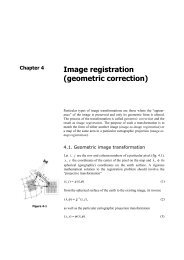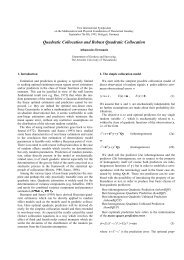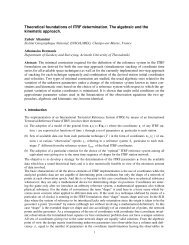Existing Landslide Monitoring Systems and Techniques
Existing Landslide Monitoring Systems and Techniques
Existing Landslide Monitoring Systems and Techniques
You also want an ePaper? Increase the reach of your titles
YUMPU automatically turns print PDFs into web optimized ePapers that Google loves.
tor), while the value of "b" represents a scale errordue to the uncertainties in the determination of therefractive index <strong>and</strong> errors in the calibration of themodulation frequency. Typically, the value of "a"ranges from 3 to 5 mm. In the highest accuracy EDMinstruments, the "a" value is 0.2 mm to 0.5 mm basedon a high modulation frequency <strong>and</strong> high resolutionof the phase measurements in those instruments. Onerecently developed engineering survey instrument isLeica DI2002 that offers a st<strong>and</strong>ard deviation of 1 mmover short distances. Over distances longer than a fewhundred meters, however, the prevailing error in allEDM instruments is due to refraction problems duringtheir propagation in the atmosphere. It is interesting toobserve that the production of high accuracy EDMinstruments (e.g. the Mekometer 5000) was discontinueddue to a small dem<strong>and</strong> <strong>and</strong> an extremely highcost.Fig. 2. Leica TM5100A high precision electronic theodolitec. Dual frequency instruments. Only a few units of adual frequency instrument (Terrameter LDM2 byTerra Technology) are available around the world.They are not really user-friendly in use but st<strong>and</strong>arddeviations of ± 0.1 mm ± 0.1 ppm may be achievedwith them. Research in the development of new dualfrequency instruments is in progress.d. Three-dimensional positioning systems. Two ormore electronic theodolites linked to a PC computercreate a three-dimensional (3D) (positioning) systemwith real-time calculations of the coordinates. Thesystems are used for the highest accuracy positioning<strong>and</strong> deformation monitoring surveys over small areasor for measurements for industrial applications. LeicaTMS <strong>and</strong> UPM400 (Geotronics, Sweden) are examplesof such systems. Positions (x, y, <strong>and</strong> z) of targetsat distances up to ten meters away may be determinedwith st<strong>and</strong>ard deviations smaller than 0.05 millimeters.These systems can be used for l<strong>and</strong>slide monitoring.In this case high accuracy theodolites measurehorizontal <strong>and</strong> vertical angles to targets on the areaunder consideration. St<strong>and</strong>ard deviations dependamong others upon the accuracy of the instrumentsused but can be kept in low values.2.3.2 Vertical control networks <strong>and</strong> heightdeterminationThe traditional technique for height determination isdifferential leveling. It provides height differencemeasurements between a series of benchmarks. Verticalpositions can be determined to very high accuracy(± 0.1 - 1 mm) over short distances (10-100's of meters)using accuracy levels. Two major classes of accuracylevels commonly used for making deformationmeasurements are automatic levels <strong>and</strong> digital levels:a. Automatic levels. The old method of geometricalleveling with horizontal lines of sight is still the mostreliable <strong>and</strong> accurate, though slow, surveying method.With high magnification leveling instruments,equipped with the parallel glass plate micrometer <strong>and</strong>with invar graduated rods, a st<strong>and</strong>ard deviationsmaller than 0.1 mm per set-up may be achieved inheight difference determination with balanced lines ofsight not exceeding 20 meters. In leveling over longdistances (with a number of instrument set-ups) ast<strong>and</strong>ard deviation of 1 mm per kilometer may beachieved in flat terrain.b. Digital levels. The digital automatic leveling systemswith height <strong>and</strong> distance readout from encodedleveling rods have considerably increased the speed ofleveling (fig. 3). There are several contradictory remarkson their performance as high accuracy levels<strong>and</strong> some improvements are expected to be introducedby the manufacturers but they can effectively be usedin l<strong>and</strong>slide monitoring if geodetic leveling is selectedas the most suitable technique for height determination.c. Zenith angle methods. High accuracy electronictheodolites <strong>and</strong> EDM equipment allow for the replacementof geodetic leveling with more economicaltrigonometric height measurements. An accuracybetter than 1 mm may be achieved in height differencedetermination between two targets 200 m apartusing accuracy electronic theodolites for vertical an-– 247 –






